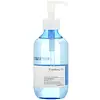What's inside
What's inside
 Key Ingredients
Key Ingredients

 Benefits
Benefits

 Concerns
Concerns

 Ingredients Side-by-side
Ingredients Side-by-side

Ethylhexyl Stearate
EmollientIsopropyl Myristate
EmollientSorbeth-30 Tetraoleate
EmulsifyingWater
Skin ConditioningDiisostearyl Malate
EmollientTocopherol
AntioxidantSimmondsia Chinensis Seed Oil
EmollientHelianthus Annuus Seed Oil
EmollientMacadamia Ternifolia Seed Oil
EmollientPrunus Amygdalus Dulcis Oil
Skin ConditioningPersea Gratissima Oil
Skin ConditioningOlea Europaea Fruit Oil
MaskingAllantoin
Skin ConditioningPanthenol
Skin ConditioningCoptis Japonica Root Extract
Skin ConditioningCentella Asiatica Extract
CleansingPortulaca Oleracea Extract
Skin ConditioningCamellia Sinensis Leaf Extract
AntimicrobialSaponaria Officinalis Leaf Extract
AntimicrobialMelaleuca Alternifolia Leaf Extract
PerfumingSodium Hyaluronate
HumectantButylene Glycol
Humectant1,2-Hexanediol
Skin ConditioningPentylene Glycol
Skin ConditioningCaprylyl Glycol
EmollientGlycerin
HumectantEthylhexyl Stearate, Isopropyl Myristate, Sorbeth-30 Tetraoleate, Water, Diisostearyl Malate, Tocopherol, Simmondsia Chinensis Seed Oil, Helianthus Annuus Seed Oil, Macadamia Ternifolia Seed Oil, Prunus Amygdalus Dulcis Oil, Persea Gratissima Oil, Olea Europaea Fruit Oil, Allantoin, Panthenol, Coptis Japonica Root Extract, Centella Asiatica Extract, Portulaca Oleracea Extract, Camellia Sinensis Leaf Extract, Saponaria Officinalis Leaf Extract, Melaleuca Alternifolia Leaf Extract, Sodium Hyaluronate, Butylene Glycol, 1,2-Hexanediol, Pentylene Glycol, Caprylyl Glycol, Glycerin
Dipropylene Glycol
HumectantMelaleuca Alternifolia Leaf Extract
PerfumingMelaleuca Alternifolia Leaf Oil
AntioxidantAlcohol Denat.
AntimicrobialTocopherol
AntioxidantPanthenol
Skin ConditioningWater
Skin ConditioningCitrus Limon Peel Oil
MaskingButylene Glycol
HumectantCitrus Aurantium Dulcis Peel Oil
MaskingLavandula Angustifolia Oil
Masking1,2-Hexanediol
Skin ConditioningEucalyptus Globulus Leaf Oil
PerfumingRosmarinus Officinalis Leaf Oil
MaskingTagetes Minuta Flower Oil
MaskingAbies Sibirica Oil
MaskingCentella Asiatica Extract
CleansingCymbopogon Schoenanthus Oil
MaskingOcimum Basilicum Oil
MaskingMadecassoside
AntioxidantMadecassic Acid
Skin ConditioningAsiaticoside
AntioxidantAsiatic Acid
Skin ConditioningLimonene
PerfumingLinalool
PerfumingDipropylene Glycol, Melaleuca Alternifolia Leaf Extract, Melaleuca Alternifolia Leaf Oil, Alcohol Denat., Tocopherol, Panthenol, Water, Citrus Limon Peel Oil, Butylene Glycol, Citrus Aurantium Dulcis Peel Oil, Lavandula Angustifolia Oil, 1,2-Hexanediol, Eucalyptus Globulus Leaf Oil, Rosmarinus Officinalis Leaf Oil, Tagetes Minuta Flower Oil, Abies Sibirica Oil, Centella Asiatica Extract, Cymbopogon Schoenanthus Oil, Ocimum Basilicum Oil, Madecassoside, Madecassic Acid, Asiaticoside, Asiatic Acid, Limonene, Linalool
 Reviews
Reviews

Ingredients Explained
These ingredients are found in both products.
Ingredients higher up in an ingredient list are typically present in a larger amount.
1,2-Hexanediol is a synthetic liquid and another multi-functional powerhouse.
It is a:
- Humectant, drawing moisture into the skin
- Emollient, helping to soften skin
- Solvent, dispersing and stabilizing formulas
- Preservative booster, enhancing the antimicrobial activity of other preservatives
Butylene Glycol (or BG) is used within cosmetic products for a few different reasons:
Overall, Butylene Glycol is a safe and well-rounded ingredient that works well with other ingredients.
Though this ingredient works well with most skin types, some people with sensitive skin may experience a reaction such as allergic rashes, closed comedones, or itchiness.
Learn more about Butylene GlycolCentella Asiatica Extract (Centella) is derived from an herb native to Southeast Asia. It is famous for its anti-inflammatory and soothing properties.
Centella is rich in antioxidants and amino acids, such as Madecassic Acid and Asiaticoside.
Studies show the compounds in centella help with:
The combination of all these properties makes centella effective at soothing, hydrating, and protecting the skin.
Other great components of centella include Vitamin A, vitamin C, several B vitamins, and Asiatic Acid.
Fun fact: Centella has been used as a medicine and in food for many centuries. As a medicine, it is used to treat burns, scratches, and wounds.
Learn more about Centella Asiatica ExtractMelaleuca Alternifolia Leaf Extract comes from the Tea Tree, Melaleuca alternifolia, Myrtaceae. This tea tree is native to Australia.
Tea Leaf extract contains antimicrobial and anti-acne properties.
This ingredient has perfuming properties and contains linalool and limonene. These fragrance and terpinen components can cause skin sensitivity.
Learn more about the benefits of Tea Tree Oil here.
Learn more about Melaleuca Alternifolia Leaf ExtractPanthenol is a common ingredient that helps hydrate and soothe the skin. It is found naturally in our skin and hair.
There are two forms of panthenol: D and L.
D-panthenol is also known as dexpanthenol. Most cosmetics use dexpanthenol or a mixture of D and L-panthenol.
Panthenol is famous due to its ability to go deeper into the skin's layers. Using this ingredient has numerous pros (and no cons):
Like hyaluronic acid, panthenol is a humectant. Humectants are able to bind and hold large amounts of water to keep skin hydrated.
This ingredient works well for wound healing. It works by increasing tissue in the wound and helps close open wounds.
Once oxidized, panthenol converts to pantothenic acid. Panthothenic acid is found in all living cells.
This ingredient is also referred to as pro-vitamin B5.
Learn more about PanthenolTocopherol (also known as Vitamin E) is a common antioxidant used to help protect the skin from free-radicals and strengthen the skin barrier. It's also fat soluble - this means our skin is great at absorbing it.
Vitamin E also helps keep your natural skin lipids healthy. Your lipid skin barrier naturally consists of lipids, ceramides, and fatty acids. Vitamin E offers extra protection for your skin’s lipid barrier, keeping your skin healthy and nourished.
Another benefit is a bit of UV protection. Vitamin E helps reduce the damage caused by UVB rays. (It should not replace your sunscreen). Combining it with Vitamin C can decrease sunburned cells and hyperpigmentation after UV exposure.
You might have noticed Vitamin E + C often paired together. This is because it is great at stabilizing Vitamin C. Using the two together helps increase the effectiveness of both ingredients.
There are often claims that Vitamin E can reduce/prevent scarring, but these claims haven't been confirmed by scientific research.
Learn more about TocopherolWater. It's the most common cosmetic ingredient of all. You'll usually see it at the top of ingredient lists, meaning that it makes up the largest part of the product.
So why is it so popular? Water most often acts as a solvent - this means that it helps dissolve other ingredients into the formulation.
You'll also recognize water as that liquid we all need to stay alive. If you see this, drink a glass of water. Stay hydrated!
Learn more about Water